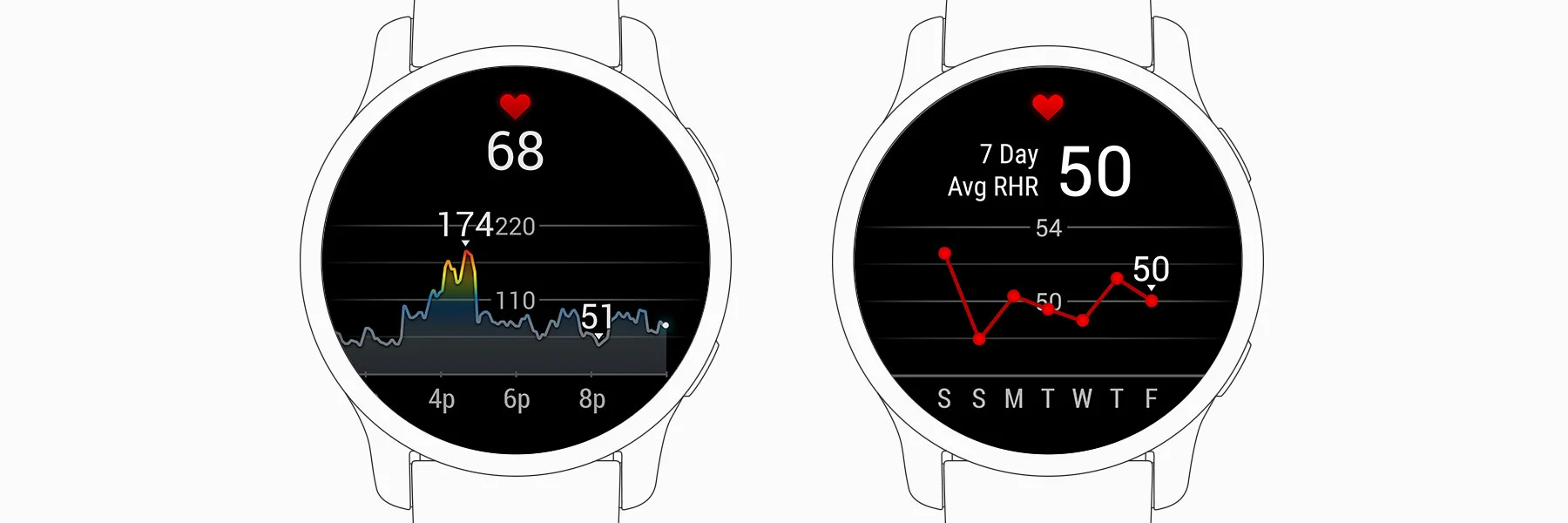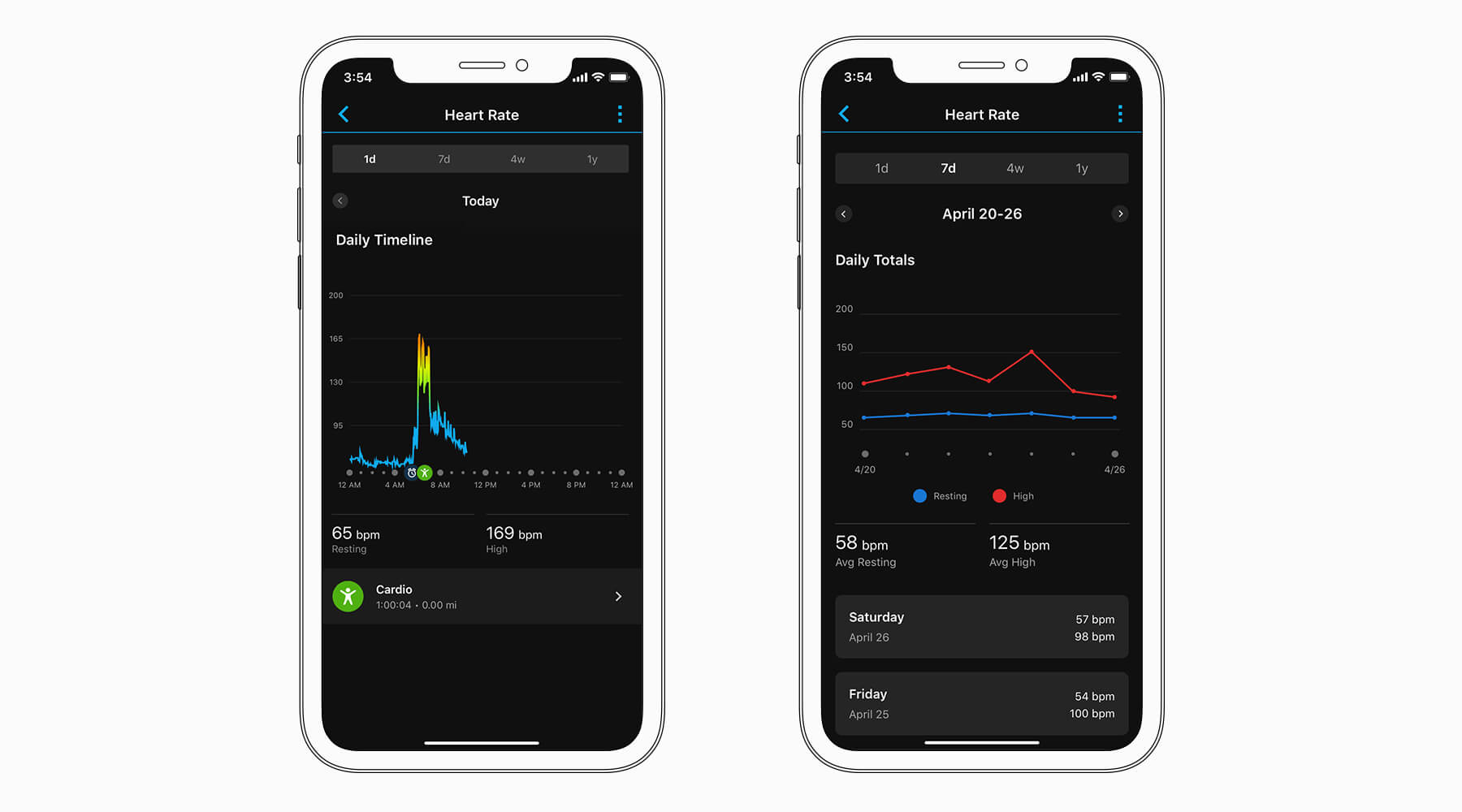
Many of the personal health and activity insights offered by Garmin wearables come directly from or by analysing heart rate data1. This includes features such as all-day stress tracking, Body Battery™ energy monitoring, respiration rate, sleep tracking and even how many calories you burn. Your heart rate can also reveal details of your cardiorespiratory fitness, measured in terms of VO2 max, when paired with walking speed, running speed or cycling power data (on compatible devices).
The human heart beats 2.5 billion times over the course of an average lifetime. With each heartbeat, oxygen, nutrients, hormones and other vital resources are delivered throughout your body by way of the circulatory system2. How your heart beats from one moment to the next is regulated by your autonomic nervous system. This vital nervous system sends instructions to your heart to physiologically prepare you for the challenges of life and environment.
Devices that offer all-day health insights based on heart monitoring data rely on the Garmin Elevate™ heart rate technology sensor, an optical (PPG) sensor built into the back of the device. It detects your heart rate by shining a green light through your skin, which is reflected by the red cells in your skin’s blood vessels.
When your heart beats, the muscular contraction of the heart itself pushes a rush of blood through your circulatory system. The cycles of this pulsing blood flow are your heart rate, or pulse, and can be detected throughout your body. Your Garmin watch conveniently measures your heart rate at the wrist.
The other option for measuring heart rate is to pair a compatible heart rate strap with your smartwatch. A heart rate strap measures the electrical signals that fire in your heart as it beats. However, this method is typically only used during recorded activities (running, cycling, cardio training, etc.). Wearing an elastic strap around your chest isn’t practical for round-the-clock monitoring, but these heart rate straps can provide reliable data even during the most vigorous, high-intensity physical activity.
The key to getting more insight from heart monitoring data is to examine the available information from multiple perspectives. For example, HR is the most common way of looking at heart monitoring data. Reported as beats per minute (bpm), this metric describes how fast your heart is beating in terms of how many beats would occur in a single minute at the current rate.
Many people find that HR provides valuable insight into exercise intensity, and they use it to guide their efforts during physical activity. An elevated HR outside of physical activity or an HR that’s too low when sedentary can each be a sign of health concerns. Compatible Garmin watches can even be configured by the user to alert them to HRs outside of a preselected range.
HRV is another measure that Garmin uses to transform your heart monitoring data into personally meaningful insight. Your heart doesn’t beat regularly like a metronome. Instead, the length of time between one heartbeat to the next is always changing. Typically measured in milliseconds, these changes aren’t huge, but they can provide a tremendous amount of information.
This is because your heart and how it beats from one moment to the next is regulated by your autonomic nervous system. As a result, the combination of HR and HRV data can be analysed and interpreted to reveal changes in the balance between sympathetic and parasympathetic branches of your nervous system. The sympathetic branch dominates the rhythm during moments of stress when the body feels that it’s time for action. The parasympathetic branch is more dominant during quieter times. Analysing the activity of these branches provides the basis for our all-day stress tracking, Body Battery energy monitoring and even some sleep tracking metrics.
RHR and HRmax are essentially the lower and upper limits of your HR. They are both important for various reasons. However, despite some similarities, each needs to be considered separately.
Your RHR changes from day to day. The RHR of normal adults can vary anywhere between 60 and 100 bpm, and some athletes can see an even lower range than that. Typically, a lower RHR reflects good cardiorespiratory fitness levels (VO2 max), adequate sleep, low stress and abstention from stimulants such as alcohol and tobacco.
Garmin wearables typically measure RHR while you are asleep, usually not long before you wake up. Consider sleeping with your watch for the most accurate measurements of your RHR.
Your HRmax is the fastest your heart can beat. Unlike RHR, your HRmax doesn’t change from one day to the next. It is also almost entirely unaffected by your fitness level, so getting into great shape won’t increase your HRmax.
Everyone’s physiology is unique, and that includes your heart. Some naturally beat a bit faster than others, and some are a bit slower. As a rule, however, your HRmax will decline as you get older. This insight is widely used to estimate an individual’s HRmax with help from the following formula: 220 – age = HRmax bpm3. If you know your own true HRmax, you can enter it on your watch or in the Garmin Connect™ app.
Heart rate zones are an easy way to see and guide the intensity of your efforts during an activity.
Personalising your heart rate zones set the stage for improving the effectiveness of your workouts over time. Avoid overdoing it in your recovery sessions, dial in better endurance training, and instantly see when it’s time to pick up the pace for a more stimulating workout. With compatible Garmin devices, you can customise activity-specific heart rate zones for running, cycling and swimming. These can be used in addition to the zones you configure for your general activity profile.
Several widely used methods exist for personalising your heart rate zones. Setting up your heart rate zones based on percentages of your maximum heart rate (%HRmax) is the most common way. Other common methods when used with compatible devices include heart rate zones as a percentage of heart rate reserve (%HRR) and factoring in your lactate threshold heart rate (%LTHR) into the mix. Each of these methods uses your maximum heart rate as a key reference.
Which method is best for you? It really depends on a combination of what you are familiar with and the resources you use for training advice. One benefit of heart rate zone training is that it allows you to follow training programs and execute workouts at the recommended intensity. Customising your zones according to %HRmax or following a program designed with %HRR zones in mind means you will be slightly underdoing it, especially during lower-intensity segments.
How you configure your personal heart rate zones does not impact advanced performance metrics such as VO2 max, training status, training load, load focus, or aerobic and anaerobic training effect feedback available on compatible Garmin devices. Overestimating or underestimating your maximum heart rate can, however, affect the reliability of these metrics.
Your maximum heart rate is relatively stable and declines slowly as you get older. This is different from your resting heart rate, which reflects changes in fitness, recovery status and dietary choices.
If you already know your maximum heart rate, simply enter your maximum heart rate in the user profile settings of your device or in the Garmin Connect app. If you don’t know your maximum heart rate, it will be automatically estimated by using the common formula of 220 minus your current age.
This formula for estimating maximum heart rate is utilised in guidelines from the American Society of Sports Medicine, which notes that while more complicated formulas exist, alternatives have not proven to be universally more reliable in practical usage4. According to this method, a 42-year-old person would have an estimated maximum heart rate of 178 bpm (220 — 42 = 178). Your maximum heart rate is likely within +/-12 bpm of this estimated value.
Estimating your maximum heart rate is a good place to start. However, knowing your own maximum heart rate and using it to personalise your heart rate zones unlocks the full potential of this training tool.
A variety of test protocols exist to determine your own personal maximum heart rate. You may also encounter your personal maximum heart rate during especially vigorous workouts that include sustained maximum-intensity efforts or during 5K/10K race events.
Tests to help you achieve your maximum heart rate are extremely demanding by design. Always consult a health professional before performing a maximum heart rate test if you are unsure of your abilities or doubt your capacity for strenuous physical activity.
Compatible Garmin devices can automatically update your maximum heart rate using your performance data. If a heart rate higher than your currently set maximum is identified and passes a reliability threshold, your personal maximum heart rate is updated on the device or in the Garmin Connect app.
Physiological Metrics -> Auto Detection Physiological Metrics -> Auto Detection menu of the device.)
Heart rate zones offer insight into the current intensity of your performance. To anticipate the fitness or performance benefits of a workout, you should consider the combination of intensity, duration, recovery and repetition. This is true for specific workouts and within the broader picture of your training plan.
Heart rate zones remove the guesswork from the intensity element of that formula.
By focusing different workouts in different zones, you can create a well-rounded training regimen that helps you gain strength, endurance, power and other benefits. In general, the lower zones are best for warmup and recovery, while the higher zones lead to improvements. The following are descriptions of our default heart rate zones. The zones may not match these descriptions if you customize them for different training purposes.
Training in zone 1 feels like a relaxed, easy pace with rhythmic breathing. It improves your heart’s abilities to pump blood and your muscles’ ability to use oxygen. Brisk walking is a typical zone 1 exercise.
Training in zone 2 is at a comfortable pace, where you’re breathing more deeply but can still hold a conversation. It’s good for recovery and basic cardiovascular training. Light jogging typically falls into zone 2.
Zone 3 training is done at a moderate pace, where it’s more difficult to hold a conversation. This strengthens your lungs and heart for more endurance. Easy running is done in zone 3.
In zone 4, you are moving at a fast, almost uncomfortable pace with forceful breathing. It improves anaerobic capacity and lactate threshold. Fast runs fall into zone 4.
When you reach zone 5, you typically are at a sprint pace that is difficult to sustain for long. Breathing is laboured. Zone 5 training builds power as well as anaerobic and muscular endurance.
